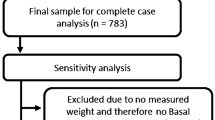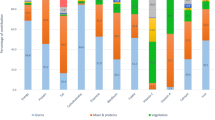Abstract
Purpose
To describe Australian pre-schooler dietary patterns and examine their associations with dietary iron intakes.
Methods
Dietary data of children (n = 812, 2 to < 6 years old) from the 2011–12 National Nutrition and Physical Activity Survey were collected via two non-consecutive 24-h recalls and analysed using AUSNUT 2011–13. Usual food and nutrient intakes were estimated via Multiple Source Method. Principal component analysis was used to extract dietary patterns from 32 food groups. Associations between dietary patterns and energy-adjusted iron intakes were assessed using linear regression, accounting for the complex survey design.
Results
Mean (SD) usual total dietary and haem iron intakes were 6.3 (1.9) and 0.5 (0.3) mg/day, respectively. Three dietary patterns were identified, explaining 14% of the variance. Pattern 1 (positive loadings for cheese, breads, fats and oils, and water) was positively associated with total dietary iron intakes (β = 0.08, 95% CI 0.01, 0.15). Pattern 3 (positive loadings for red meat, fortified fruit and vegetable products, and sauces and spreads) was negatively associated with total dietary iron (β = − 0.08, 95% CI − 0.14, − 0.01) and non-haem iron (β = − 0.09, 95% CI − 0.15, − 0.02) intakes. No dietary patterns were associated with haem iron intakes.
Conclusions
Three main patterns characterise Australian pre-schooler diets. The pattern with which dietary iron is positively associated is predominately characterised by non-haem iron sources and non-iron-fortified foods. Future research is required to estimate the iron bioavailability of Australian pre-schooler diets.
Similar content being viewed by others
References
McLean E, Cogswell M, Egli I, Wojdyla D, de Benoist B (2009) Worldwide prevalence of anaemia, WHO vitamin and mineral nutrition information system, 1993–2005. Public Health Nutr 12(04):444–454. https://doi.org/10.1017/S1368980008002401
World Health Organization, United Nations Children’s Fund, United Nations University (2001) Iron deficiency anaemia: assessment, prevention and control. A guide for programme managers. World Health Organization. http://whqlibdoc.who.int/hq-/2001./WHO_NHD_01.3.pdf. Accessed 26 May 2017
Institute for Health Metrics and Evaluation (2013) Global burden of disease profile: Australia. Institute for Health Metrics and Evaluation. Seattle, USA. https://www.healthdata.org/sites/default/files/files/country_profiles/GBD/ihme_gbd_country_report_australia.pdf
Georgieff MK (2007) Nutrition and the developing brain: nutrient priorities and measurement. Am J Clin Nutr 85(2):614S-620S
Rao R, Georgieff MK (2007) Iron in fetal and neonatal nutrition. Semin Fetal Neonatal Med 12(1):54–63. https://doi.org/10.1016/j.siny.2006.10.007
Beard JL (2008) Why iron deficiency is important in infant development. J Nutr 138(12):2534–2536
Grantham-McGregor S, Ani C (2001) A review of studies on the effect of iron deficiency on cognitive development in children. J Nutr 131(2):649S-668S
Lozoff B, Beard J, Connor J, Felt B, Georgieff M, Schallert T (2006) Long-lasting neural and behavioral effects of iron deficiency in infancy. Nutr Rev 64(5 Part 2):S34-43
Thane CW, Walmsley CM, Bates CJ, Prentice A, Cole TJ (2000) Risk factors for poor iron status in British toddlers: further analysis of data from the national diet and nutrition survey of children aged 1.5–4.5 years. Public Health Nutr 3(4):433–440
Atkins LA, McNaughton SA, Spence AC, Szymlek-Gay EA (2020) Adequacy of iron intakes and socio-demographic factors associated with iron intakes of Australian pre-schoolers. Eur J Nutr 59(1):175–184. https://doi.org/10.1007/s00394-019-01897-7
Finberg KE (2013) Regulation of systemic iron homeostasis. Curr Opin Hematol 20(3):208–214. https://doi.org/10.1097/MOH.0b013e32835f5a47
Hallberg L, Hulthén L (2000) Prediction of dietary iron absorption: an algorithm for calculating absorption and bioavailability of dietary iron [corrected] [published erratum appears in AM J CLIN NUTR 2000 Nov; 72(5): 1242]. Am J Clin Nutr 71(5):1147–1160
Gibson RS (2005) Principles of nutritional assessment, 2nd edn. Oxford University Press, Oxford
Hurrell R, Egli I (2010) Iron bioavailability and dietary reference values. Am J Clin Nutr 91(5):1461S-1467S. https://doi.org/10.3945/ajcn.2010.28674F
Cook JD, Layrisse M, Martinez-Torres C, Walker R, Monsen E, Finch CA (1972) Food iron absorption measured by an extrinsic tag. J Clin Invest 51(4):805–815. https://doi.org/10.1172/JCI106875
Hallberg L, Hoppe M, Andersson M, Hulthén L (2003) The role of meat to improve the critical iron balance during weaning. Pediatrics 111(4):864–870
McNaughton SA (2010) Dietary patterns and diet quality: approaches to assessing complex exposures in nutrition. Australas Epidemiol 17(1):35–37
Golley RK, Smithers LG, Campbell K, Lynch J (2010) Understanding the role of infant and toddler nutrition on population health: epidemiological resources in Australasia. Australas Epidemiol 17(1):11–16
Marshall S, Burrows T, Collins CE (2014) Systematic review of diet quality indices and their associations with health-related outcomes in children and adolescents. J Hum Nutr Diet 27(6):577–598. https://doi.org/10.1111/jhn.12208
Kranz S, Hartman T, Siega-Riz AM, Herring AH (2006) A diet quality index for American preschoolers based on current dietary intake recommendations and an indicator of energy balance. J Am Diet Assoc 106(10):1594–1604
Smithers LG, Golley RK, Brazionis L, Emmett P, Northstone K, Lynch JW (2012) Dietary patterns of infants and toddlers are associated with nutrient intakes. Nutrients 4(8):935–948
Voortman T, Kiefte-de Jong JC, Geelen A, Villamor E, Moll HA, de Jongste JC, Raat H, Hofman A, Jaddoe VWV, Franco OH, van den Hooven EH (2015) The development of a diet quality score for preschool children and its validation and determinants in the generation R study. J Nutr 145(2):306–314. https://doi.org/10.3945/jn.114.199349
Shin KO, Oh SY, Park HS (2007) Empirically derived major dietary patterns and their associations with overweight in Korean preschool children. Br J Nutr 98(2):416–421
Pryer JA, Rogers S (2009) Dietary patterns among a national sample of British children aged 1 1/2-4 1/2 years. Public Health Nutr 12(7):957–966. https://doi.org/10.1017/S1368980008003364
LaRowe TL, Moeller SM, Adams AK (2007) Beverage patterns, diet quality, and body mass index of US preschool and school-aged children. J Am Diet Assoc 107(7):1124–1133
Manios Y, Kourlaba G, Kondaki K, Grammatikaki E, Birbilis M, Oikonomou E, Roma-Giannikou E (2009) Diet quality of preschoolers in greece based on the healthy eating index: the GENESIS study. J Am Diet Assoc 109(4):616–623. https://doi.org/10.1016/j.jada.2008.12.011
Banfield EC, Liu Y, Davis JS, Chang S, Frazier-Wood AC (2016) Poor adherence to US dietary guidelines for children and adolescents in the National Health and Nutrition Examination Survey population. J Acad Nutr Diet 116(1):21–27. https://doi.org/10.1016/j.jand.2015.08.010
Golley RK, Hendrie GA, McNaughton SA (2011) Scores on the dietary guideline index for children and adolescents are associated with nutrient intake and socio-economic position but not adiposity. J Nutr 141(7):1340–1347
Cribb V, Emmett P, Northstone K (2013) Dietary patterns throughout childhood and associations with nutrient intakes. Public Health Nutr 16(10):1801–1809. https://doi.org/10.1017/S1368980012004132
Hu FB (2002) Dietary pattern analysis: a new direction in nutritional epidemiology. Curr Opin Lipidol 13(1):3–9
Australian Bureau of Statistics (2013) Australian Health Survey: Users’ Guide, 2011–13, cat. no. 4363.0.55.001. ABS. http://www.abs.gov.au/ausstats/abs@.nsf/Lookup/74D87E30B3539C53CA257BBB0014BB36?opendocument Accessed 26 May 2017
Cole TJ, Bellizzi MC, Flegal KM, Dietz WH (2000) Establishing a standard definition for child overweight and obesity worldwide: international survey. BMJ 320(7244):1240–1243
Cole TJ, Flegal KM, Nicholls D, Jackson AA (2007) Body mass index cut offs to define thinness in children and adolescents: international survey. BMJ 335(7612):194
Blanton CA, Moshfegh AJ, Baer DJ, Kretsch MJ (2006) The USDA automated multiple-pass method accurately estimates group total energy and nutrient intake. J Nutr 136(10):2594–2599
Food Standards Australia New Zealand (2015) AUSNUT 2011–13- Australian food, supplement and nutrient database for estimation of population nutrient intakes. FSANZ. http://www.foodstandards.gov.au/science/monitoringnutrients/ausnut/Pages/about.aspx. Accessed 16 Apr 2018
Rangan AM, Ho RWL, Blight GD, Binns CW (1997) Haem iron content of Australian meats and fish. Food Aust 49(11):508–511
Cosgrove M, Flynn A, Kiely M (2005) Impact of disaggregation of composite foods on estimates of intakes of meat and meat products in Irish adults. Public Health Nutr 8(3):327–337
Prynne CJ, Wagemakers JJMF, Stephen AM, Wadsworth MEJ (2009) Meat consumption after disaggregation of meat dishes in a cohort of British adults in 1989 and 1999 in relation to diet quality. Eur J Clin Nutr 63(5):660–666. https://doi.org/10.1038/ejcn.2008.7
Sui Z, Raubenheimer D, Rangan A (2017) Consumption patterns of meat, poultry, and fish after disaggregation of mixed dishes: secondary analysis of the Australian National Nutrition and Physical Activity Survey 2011–12. BMC Nutr 3:52. https://doi.org/10.1186/s40795-017-0171-1
National Health and Medical Research Council (2013) Eat for health. Educator guide: Information for nutrition educators. National Health and Medical Research Council, Canberra
Lei L, Rangan AM, Flood VM, Louie JCY (2016) Dietary intake and food sources of added sugar in the Australian population—CORRIGENDUM...Lei L, Rangan A, Flood VM, et al. (2016) Dietary intake and food sources of added sugar in the Australian population. British Journal of Nutrition 115: 868–877. 116: 1136–1136. https://doi.org/10.1017/S0007114516003093
Livingstone KM, McNaughton SA (2017) Dietary patterns by reduced rank regression are associated with obesity and hypertension in Australian adults. Br J Nutr 117(2):248–259. https://doi.org/10.1017/S0007114516004505
Harttig U, Haubrock J, Knuppel S, Boeing H (2011) The MSM program: web-based statistics package for estimating usual dietary intake using the multiple source method. Eur J Clin Nutr S1:87
Ferguson E, Cox T (1993) Exploratory factor analysis: a users’guide. Int J Select Assess 1(2):84–94. https://doi.org/10.1111/j.1468-2389.1993.tb00092.x
Akkermans MD, van der Horst-Graat JM, Eussen SRBM, van Goudoever JB, Brus F (2016) Iron and Vitamin D deficiency in healthy young children in Western Europe despite current nutritional recommendations. J Pediatr Gastroenterol Nutr 62(4):635–642. https://doi.org/10.1097/MPG.0000000000001015
Eussen S, Alles M, Uijterschout L, Brus F, van der Horst-Graat J (2015) Iron intake and status of children aged 6–36 months in Europe: a systematic review. Ann Nutr Metab 66(2–3):80–92. https://doi.org/10.1159/000371357
Karr MA, Mira M, Alperstein G, Labib S, Webster BH, Lammi AT, Beal P (2001) Iron deficiency in Australian-born children of Arabic background in central Sydney. Med J Aust 174(4):165–168
Institute of Medicine, Food and Nutrition Board (2001) Dietary reference intakes for vitamin A, Vitamin K, Arsenic, Boron, Chromium, Copper, Iodine, Iron, Manganese, Molybdenum, Nickel, Silicon, Vanadium, and Zinc. The National Academies Press. http://www.nap.edu/openbook.php?record_id=10026. Accessed 26 May 2017
Zimmermann MB, Chaouki N, Hurrell RF (2005) Iron deficiency due to consumption of a habitual diet low in bioavailable iron: a longitudinal cohort study in Moroccan children. Am J Clin Nutr 81:115–121
Hurrell RF, Reddy MB, Juillerat M, Cook JD (2003) Degradation of phytic acid in cereal porridges improves iron absorption by human subjects. Am J Clin Nutr 77(5):1213–1219
Hallberg L, Rossander L, Skånberg AB (1987) Phytates and the inhibitory effect of bran on iron absorption in man. Am J Clin Nutr 45(5):988–996. https://doi.org/10.1093/ajcn/45.5.988
Kant AK (2004) Dietary patterns and health outcomes. J Am Diet Assoc 104(4):615–635. https://doi.org/10.1016/j.jada.2004.01.010
Smithers LG, Golley RK, Brazionis L, Lynch JW (2011) Characterizing whole diets of young children from developed countries and the association between diet and health: a systematic review. Nutr Rev 69(8):449–467
Acknowledgements
SA McNaughton was supported by a National Health and Medical Research Council Career Development Fellowship Level 2 (ID1104636, 2016–2019).
Author information
Authors and Affiliations
Contributions
EAS-G conceptualized the study and all authors contributed to its design and data analysis plan; LAA prepared the haem iron database with advice from EAS-G; LAA performed the statistical analyses and drafted the manuscript. All authors contributed to a critical review of the manuscript during the writing process and approved the final version as submitted.
Corresponding author
Ethics declarations
Conflict of interest
The authors declare that they have no conflict of interest.
Ethical standards
The Census and Statistics Act, 1905 provides the authority for the Australian Bureau of Statistics to collect statistical information and requires that statistical output shall not be published or disseminated in a manner that is likely to enable the identification of a particular person or organisation. Therefore, all information received by the Australian Bureau of Statistics has been treated in strict confidence as required by the Census and Statistics Act 1905.
Supplementary Information
Below is the link to the electronic supplementary material.
Rights and permissions
About this article
Cite this article
Atkins, L.A., McNaughton, S.A., Spence, A.C. et al. Dietary patterns of Australian pre-schoolers and associations with haem and non-haem iron intakes. Eur J Nutr 60, 3059–3070 (2021). https://doi.org/10.1007/s00394-020-02477-w
Received:
Accepted:
Published:
Issue Date:
DOI: https://doi.org/10.1007/s00394-020-02477-w




